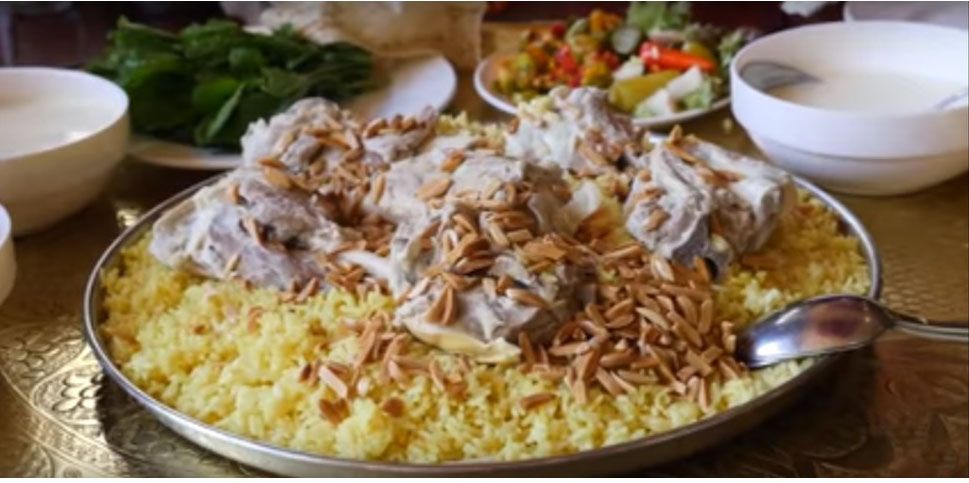It’s Gotta Be More Than a Fig Leaf

In America you can see everything from modest Amish clothing to the Naked Cowboy of New York’s Times Square. We are an eclectic nation. Muslim countries are not amused at the way we choose to cover—or uncover—ourselves. If you are traveling to any Muslim country, do your homework ahead of time to save yourself some grief.
Modesty in any culture equates to wearing loose clothing which covers skin. One’s apparel talks about them. When clothing speaks, it reveals religion, culture, style, day of the week, season of the year, climate, and destination. All of these change over time and by degree. Clothes can’t be silent, and everyone listens.
In visiting Jordan, where Islam is the dominant religion, one of the first considerations is about appropriate dress. That’s valid. It is widely known that Middle East clothing is more conservative than in the West.
Muslims consider their centuries-old practice protective, especially of women. However, in Jordan it is less restrictive compared with many of its neighbors because their culture is more heavily influenced by the West.
Keep in mind that as a foreign guest in Jordan, you will be welcome to stay as long as you observe etiquette. Otherwise, you will be considered rude and unwelcome. With that, let’s look at some of Jordan’s attire expectations.
Jordan is the most progressive of the Muslim countries. King Abdullah II and his family lead the way to bring their people along with them.
Dynamic tension is at play. Whereas the younger population is becoming more western-thinking, the older is reluctant to abandon their historical way of life. It’s the same phenomenon every culture deals with. Time and exposure to the rest of the world brings change—for good or bad.
Clothing Points for Men
When we were in Jordan, we observed a variety of dress. Let’s look at the men first.
Casual mixed with some religious attire is what we saw. Pullover knits and full-length, buttoned-front shirts are most common. Shirt tails were either in or out. We saw some T-shirts, but they are less acceptable
Trousers are casual too. We saw denim jeans as well as brown, khaki, black, and navy slacks. There is nothing jarring there. Sometimes we saw a suit with or without a tie.
Long pants are best. Even men show modesty. For young boys, the standard is more relaxed, and shorts are acceptable.
Men in shorts are still a bit edgy, but if you wear them, keep them loose and knee-length rather than the form-fitting, sports type.
Often, local men dress in the cultural dishdasha (an ankle-length, long- sleeved robe).

Along with this, they also wear a takiyan (skullcap) or their traditional tribal kufyah (also spelled keffiyeh or kefiyah) with a black igal (a rope-like head band to hold it in place).
In Jordan, the red-and-white keffiyeh is strongly associated with the country and its heritage, because the red color was introduced by the Jordanian Bedouins under British rule, where it is known as the shemagh mhadab. The Jordanian keffiyeh has decorative cotton or wool tassels on the sides; the bigger these tassels, the greater the garment’s supposed value and the status of the person wearing it. It has long been worn by Bedouins and villagers and used as a symbol of honor and/or tribal identification. The tasseled red-and-white Jordanian shemagh is much thicker than the untasseled red-and-white shemagh seen in Persian Gulf countries.[1]
Wearing a kufyah is not restricted to Jordanians. Men, women, and children visitors buy them to wear while in country and take them home as a souvenir. They are readily available in many shops with attendants eager to help you wrap it.

Leather sandals, flip-flops, and tennis shoes are common. In many open-air shops, we saw large displays of colorful, plastic shoes—similar to Crocs---with holes in the top to let the feet breathe. Apparently there is a big demand for them from all ages regardless of gender.
Although street wear is casual, that is not to say there is no upscale style in Jordan. Take a look at the Crown Prince. Now here is a sharp dresser who goes casual as well.

Dressed as an official of the kingdom, a college student, or just hanging out with his sister, you can see him in clothing you would probably wear.


The occasion governs the apparel. Generally, in all countries, everyone wants to appear handsome, beautiful, and appropriate, and at the same time, display their uniqueness.
In Jordan, there will not be an occasion for you to dress like this, however.

Any top that doesn’t cover your shoulders and upper arms counts as underwear. Underwear should also have outerwear.
Keep your shirt on. Not wearing one is unacceptable.
For both men and women, swimsuits are only for the pool and the sea. When going or coming in—even in the hotel lobby—be prepared to cover.
Jordanian swimmers wear a top over their swimwear.
Clothing Points for Women
Many women in Jordan wear western clothing, but they cover more skin than we do.
Relax. The hijab is not required for visitors or even for Jordanian women. They have a choice.
A western travel blogger visiting and writing about Jordanian culture has a website you might find helpful. She shows some sample pictures of her wardrobe when she traveled to Jordan.
There are plenty of other internet sites to round-out your knowledge about appropriate clothing in Jordan.


Both of the above pictures are from the same website.
Avoid wearing T-shirts, shorts, and leggings, which can be regarded as sexual clothing.
Showing cleavage or your back is in bad taste. Tight, form-fitting clothing is less offensive than showing skin.
The nape of the neck is considered particularly erotic and is best covered, either by a high collar or a scarf. Elvis would have had no problem.
Legs are best covered at least to the knee.
Women’s hair should be dry. Wet hair suggests sexual availability.
Many female residents wear a headscarf, and those who choose not to usually keep their hair tied up. Female tourists should also try to follow this etiquette and tie their hair back.
A headscarf will come in handy to protect your head and neck from the harsh sun and dusty wind. In some places, a scarf over your head will feel more appropriate. The situation and location will determine what is best.
In the souk (market), are an abundance of beautiful scarves. We bought a lot of them to share as gifts when we returned home.
In short, plan to be a good guest ahead of time. Learn about how people in your host country live, act, dress, and eat, and know what is acceptable behavior.
When you realize you made a mistake, place a hand over your heart and offer a gracious apology. This gesture will bring you back into good graces.
For more pictures and thoughts on what to wear, check out this traveler’s site.
A few months ago Anita addressed her blog to culture. Since this is such an important subject, some repetition helps us become well versed. You may want to review the fourteen subjects this site provides. I found the subjects it covers very helpful.
- Dress codes
- Male dress code in Jordan
- Female dress code in Jordan
- Social interactions
- Personal space
- Invitations
- How to dine like local Jordanians
- Answering questions
- Photography
- LGBTQ travelers in Jordan
- Travel advice for women in Jordan
- Gestures and body language
- The meaning of coffee
- Words of welcome
Here is a website with more helpful tips on Jordanian etiquette.
My last thread is about a clothing manufacturer in Jordan. No pun intended.
On May 5, 2018, the Jordan Times reported on a company established in the year 2000. Here are excerpts from that article:
Nasdaq announced the start of stocks trading for Jerash Garments and Fashions Manufacturing Company (JFGM). It is Jordan’s first company to be listed on the stock exchange.[2]
It was established in 2000 and “…is an approved manufacturer by many well-known brand and retailers in Europe and the US, including Walmart, Costco, Sears, Hanes, Columbia, The North Face, Timberland, Wrangler, Lee, Calvin Klein, Tommy Hilfiger, and Speedo.”[3] The company has more than 2,800 employees.
As you see, from this post, there are a few guidelines on dress to observe while visiting Jordan. If you follow this information, it should keep you in good stead with your gracious host.
Travel to Jordan need not be viewed as dress-restrictive but merely conservative-casual.
Your present wardrobe may not need altering at all. If it does, the adjustments you make can still be used when you return home. Make your trip hassle-free by following cultural expectations.
Here is a bonus this week. While mansaf has nothing to do with clothing, it is the most traditional Jordanian dish. Maybe you would like to try it.

Mansaf (Fatiyyeh)
Ingredients
1 cup of orzo, rice-shaped pasta
Water
Dash of salt
3 pounds lean lamb chunks (or the meat of your choice)
1 large onion, finely chopped
¼ teaspoon black pepper
1 teaspoon ground allspice
4 loaves pita bread, or 2 loaves shraj bread
3 cups cooked white rice
½ cup sautéed pine nuts
Directions
- Cook orzo according to package directions; purée it with a little plain yogurt and a dash of salt in a blender or food processor to make a sauce.
- Place lamb chunks and 4 cups of water into a large kettle, and bring the water to a boil.
- Add chopped onion, black pepper, and ground allspice, and simmer for about one hour.
- Add the puréed kishk to the stewed lamb mixture in the kettle. Simmer for another hour.
- While the stew is simmering, cut rounds of pita bread into quarters. Cover the bottom of a large round pan with 2 layers of pita pieces.
- When the lamb mixture has finished simmering, ladle about 2 cups of the orzo sauce over the pita bread and allow to soak 10 minutes.
- Spread rice over the soaked bread. Ladle another cup of sauce over the entire pan, and cover the rice with all of the lamb chunks. Sprinkle pine nuts over the lamb and serve.
Read more at https://www.everyculture.com/wc/Japan-to-Mali/Jordanians.html#ixzz6CEsY1nCf
There is much to see and do in Jordan. If your experience is anything like ours, you’re in for a great time.
When you return, we would love to hear about your experiences.
Al
[1] https://en.wikipedia.org/wiki/Keffiyeh Accessed 07/14/20
[2] http://www.jordantimes.com/news/business/jerash-garments-company-listed-nasdaq Accessed 05/01/20
[3] http://jordantimes.com/news/local/king-joins-workers-garment-factory-labour-day-celebration
Accessed 05/01/20
